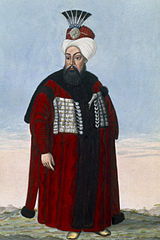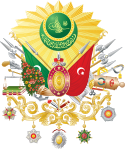Ahmed II
| ||
 | ||
 Tugra Ahmeda II | ||
 | ||
| Sułtan Imperium Osmańskiego | ||
| Okres | od 1691 do 6 lutego 1695 | |
| Koronacja | 22 czerwca 1691 | |
| Poprzednik | Sulejman II | |
| Następca | Mustafa II | |
| Dane biograficzne | ||
| Dynastia | Osmanowie | |
| Data urodzenia | 25 lutego 1643 | |
| Data i miejsce śmierci | 6 lutego 1695 Adrianopol | |
| Ojciec | Ibrahim I | |
| Matka | Hatice Muazzez | |
| Rodzeństwo | Mehmed IV, Sulejman II | |
| Małżeństwo | Rabia Haseki Sultan Sayeste Hatun | |
Ahmed II (ur. 25 lutego 1643, zm. 6 lutego 1695 w Adrianopolu) – sułtan z dynastii Osmanów panujący w latach 1691-95.
Syn Ibrahima I, brat Mehmeda IV i Sulejmana II. Zasiadł na tronie po śmierci Sulejmana II. Okres jego panowania wypełniły ciągłe porażki militarne Osmanów. U progu jego rządów armia turecka pod dowództwem wielkiego wezyra Fazila Mustafy Köprülü poniosła klęskę pod Slankamen, wskutek czego Osmanowie utracili ostatnie posiadłości węgierskie. Tron po nim objął jego bratanek Mustafa II.
Bibliografia
- Małgorzata Hertmanowicz-Brzoza: Słownik władców świata. Kraków: Wydawnictwo Zielona Sowa, 2005. ISBN 83-7435-077-6.
| ||||
Media użyte na tej stronie
Every sultan of the Ottoman Empire had his own monogram, called the tughra, which served as a royal symbol. A coat of arms in the European heraldic sense was created in the late 19th century. Hampton Court requested from the Ottoman Empire a coat of arms to be included in their collection. As the coat of arms had not been previously used in the Ottoman Empire, it was designed after this request, and the final design was adopted by Sultan Abdul Hamid II on 17 April 1882.
Autor: Buho07, Licencja: CC BY-SA 3.0
Ottoman Imperial Standard, Late 19th and early 20th Century. Each Sultan had his own Tughra.
Every sultan of the Ottoman Empire had his own monogram, called the tughra, which served as a royal symbol. A coat of arms in the European heraldic sense was created in the late 19th century. Hampton Court requested from the Ottoman Empire a coat of arms to be included in their collection. As the coat of arms had not been previously used in the Ottoman Empire, it was designed after this request, and the final design was adopted by Sultan Abdul Hamid II on 17 April 1882.
Tughra (i.e., seal or signature) of Ahmed II, Sultan of the Ottoman Empire (1691-1695). An explanation of the different elements composing the tughra can be found here.
Portrait of Ahmed II, Sultan of the Ottoman Empire (1691-1695). The portrait has been printed using the Giclée process.



